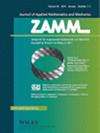Fully developed opposing mixed convection of a Jeffery tri‐hybrid nanofluid between two parallel inclined plates subjected to wall‐slip condition
IF 3.2
4区 工程技术
Q1 MATHEMATICS, APPLIED
Zamm-zeitschrift Fur Angewandte Mathematik Und Mechanik
Pub Date : 2023-10-05
DOI:10.1002/zamm.202300177
引用次数: 0
Abstract
Abstract We analyze the effect of wall slip on the fully developed reverse mixed convection of Jeffery nanofluids between two inclined parallel plates with uniform wall heat flux conditions. The theory of tri‐hybrid water‐based nanoparticles with unique shapes, namely, cylindrical (copper), spherical (titanium oxide), and platelet (aluminum oxide) for heat transfer enhancement is utilized since it has better heat performance applicable in a dynamic of fuels and coolant in automobiles as compared with regular Newtonian fluid and nanofluid. The equations describing the above transport phenomena are nondimensional through appropriate scale transformations. Analytical solutions for velocity, temperature, and pressure distributions are obtained. Four different flow regimes including no reversal, bottom reversal, top reversal, and on both walls reversal are found for different combinations of buoyancy and pressure. Particularly, we notice that the wall slip significantly affects flow reversal. Furthermore, we notice that Magyari 's conclusion that the results of the homogeneous nanofluid flow model can be recovered from the corresponding Newtonian fluid model has great limitations. Besides, the effect of several physical factors on velocity and temperature distributions and important physical quantities, including skin friction coefficient and Nusselt number, are analyzed and graphically discussed.杰弗里三杂化纳米流体在受壁滑移条件的两个平行倾斜板之间完全发展的反向混合对流
摘要在均匀壁面热流条件下,分析了壁面滑移对两个倾斜平行板间Jeffery纳米流体充分发展的反向混合对流的影响。与常规牛顿流体和纳米流体相比,三混合水基纳米颗粒具有独特的形状,即圆柱形(铜),球形(氧化钛)和片状(氧化铝),用于增强传热,因为它具有更好的热性能,适用于燃料和汽车冷却剂的动态。通过适当的尺度变换,描述上述输运现象的方程是无量纲的。得到了速度、温度和压力分布的解析解。在不同的浮力和压力组合下,发现了四种不同的流动状态,包括无反转、底部反转、顶部反转和双壁面反转。特别地,我们注意到壁面滑移显著地影响流动逆转。此外,我们注意到Magyari关于均质纳米流体流动模型的结果可以从相应的牛顿流体模型中恢复的结论具有很大的局限性。此外,还分析了几种物理因素对速度和温度分布的影响以及重要物理量,包括表面摩擦系数和努塞尔数,并进行了图解讨论。
本文章由计算机程序翻译,如有差异,请以英文原文为准。
求助全文
约1分钟内获得全文
求助全文
来源期刊
CiteScore
3.30
自引率
8.70%
发文量
199
审稿时长
3.0 months
期刊介绍:
ZAMM is one of the oldest journals in the field of applied mathematics and mechanics and is read by scientists all over the world. The aim and scope of ZAMM is the publication of new results and review articles and information on applied mathematics (mainly numerical mathematics and various applications of analysis, in particular numerical aspects of differential and integral equations), on the entire field of theoretical and applied mechanics (solid mechanics, fluid mechanics, thermodynamics). ZAMM is also open to essential contributions on mathematics in industrial applications.

 求助内容:
求助内容: 应助结果提醒方式:
应助结果提醒方式:


